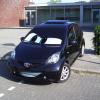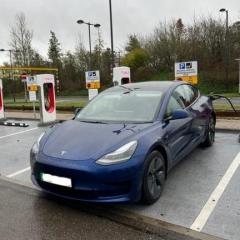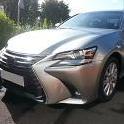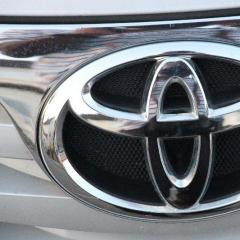Leaderboard
Popular Content
Showing content with the highest reputation on 09/19/2016 in all areas
-
This weekend, I had been to south wales and clocked up 461 miles and still had 19 miles left. Still only 36 litres, the range did go up to 494 miles after I had filled up. I'm sure somebody had said, once you reach 40,000 miles the car appears to give the best results, if that is the case I have only 2000 miles to go.1 point
-
change the head unit to one that has bluetooth ,head units aren't expensive these days. our aygo had the bluetooth through the tomtom sat nav.1 point
-
There are lots of options, but I thought this car has Bluetooth built in! Does the steering wheel have phone call buttons? The other clue is the small microphone grill in the light front interior light fittings of the headlining. Do you have the handbooks that came with the car? That will confirm and instruct owners if Bluetooth is part of the car and how to use it. My current '09 Avensis TR has Bluetooth built in, even though I added another Bluetooth via a USB/microSD/Aux adapter I installed. Here is an earlier post - The Parrot range is good. With my old Mk1 Avensis, I had a Novero (similar to Parrot) and all you needs is SOT-062 Toyota to ISO lead. The system was straight forward (for me) to install. I retained my Novero kit since it works with any car, as will the Parrot. Once setup, Bluetooth normal is very simple and foolproof. Auto connects and if the phone supports auto answer - Windows phones don't auto answer, but Android and iPhone does.1 point
-
The big unknown is what she wants to "use" her phone for. (And to some extent what the phone itself may be capable of.) If the requirement is simply to answer a call while driving, then things can be pretty simple, cheap and independent of the car. Start either with a Bluetooth headset, or the type of thing that Frostyballs has linked. Getting voice-activation of smartphone features (like Siri or Google Now) with auto-muting of the radio, music streaming, dictation and reading of text messages, etc would be much more expensive and difficult to integrate with the built-in systems. Time to research the requirements (and budget) before seeking out solutions! And, ahem, its not as though being 60 (by itself), or even female and 60, meant auto-disqualification from being able to press buttons or think. "OAP-proof" indeed ...1 point
-
Could consider something like an xcarlink - http://www.xcarlink.co.uk/home.php?cat=11 - which provides bluetooth as one of the options , or a sun visor fitting such as - https://www.amazon.co.uk/MULTIPOINT-Bluetooth-Handsfree-Speakerphone-Smartphones/dp/B01HCG2174/ref=sr_1_2?ie=UTF8&qid=1474108673&sr=8-2-spons&keywords=bluetooth%2Bfor%2Bcar&th=1 or https://www.amazon.co.uk/MULTIPOINT-Bluetooth-Handsfree-Speakerphone-Smartphones/dp/B00SSM6L4Q/ref=sr_1_2?ie=UTF8&qid=1474108673&sr=8-2-spons&keywords=bluetooth+for+car&psc=11 point
-
Aygo - 'in a nutshell' "Aygo" is the phonetic representation of the Japanese word for "English" (Eigo). Pronounced 'I GO' and launched in July 2005 the Aygo is smaller than a modern mini but with clever design has a large interior feel. This car is the child of a joint venture between Toyota, Peugeot and Citroen. By sharing development and manufacturing costs at the assembly plant at Kolin in the Czech Republic (which produces 300 000 cars a year) the 3 manufacturers are able to share platform and running gear but customise their own models with trim and cosmetics to produce the Peugeot 107, Citroen C1 and of course the Toyota Aygo. Built to a high safety standard and with good levels of equipment the car offers a great choice for compact motoring. With low emissions it has a cheap VED banding and is in group 1E (the lowest) insurance category. The small light engine offers good fuel economy but is still able to keep up with traffic pace due to power to weight ratios. The petrol model weighs 890kg - about the same as a blue whale's heart ! A relatively affordable, reliable, runaround car which is cheap to run but has contemporary looks. For a really detailed look at they Aygo including design, chassis, engine, safety, running costs and full specs try this informative site HERE. What Car? have reviewed the Aygo - see the video HERE What is the difference between the Aygo, Aygo +, Aygo Black and Sport trim levels ? The entry-level car is only available in CHILLI RED but is well equipped and includes colour keyed bumpers, rake adjustable steering wheel, twin front airbags, and anti lock brakes with the backup of electronic brakeforce. Add £500 and you move up to the '+' grade which adds upgraded 'flint' cloth seats, 4 more speakers (2 in the rear and 2 small tweeters in the front), the option of metallic paint (extra cost) in CARBON QUARTZ, ICE BLUE or CRYSTAL SILVER, adjustable rear headrests, colour-keyed door mirrors and handles, electric front windows, a split folding rear seat, remote central locking, side airbags and an ISOFIX child seat attachment. Fork out another £500 (£1000 more than the base model) and the Aygo Sport is in reach which gives you in addition to the '+' model spec 14-inch alloy wheels, integrated front fog lights and a rev counter. We think it's a bit annoying that a rev counter is only available on the top spec car - however it is easier than you might think to add one to a 'basic' or 'plus' model yourself using original parts with an end state rev counter that will be indistinguishable from one supplied with a top spec car. The total cost of the parts is around £135 and detail of the part numbers and installation process with step by step photos can be found HERE. In July 2006 a special edition BLACK model was released. This is based on the '+' model but gains black paint included in price, special edition 8 spoke 14-inch alloy wheels, black leather gear knob and aluminium door sill scuff plates with Aygo logo. Prices for the 'black' are approx same as 'sport'. On 14 May 2007 a special edition Aygo BLUE was launched and will feature (as well as the standard met blue paint) a blue speedometer surround, blue stitching in the carpet mats and gear lever gaitor, bluetooth connection, door scuff plates, glove box lid and air con. From the summer of 2007 the 'Sport' model was deleted from the range. Air conditioning is not available on base model and is a cost option for both the '+' and the Sport. Adding the cost option of Air Con also provides an air recirculation control (choice interior air recirculated or fresh air from outside). Auto is not available on base model and is a cost option for both the '+' and the Sport petrol models. A diesel engine is available from model launch until summer 2007 when it was deleted from the range. This engine is not available on base model. All trim levels / engine types are available in either 3 or 5 door variants. What is the fuel economy like ? The official Toyota combined cycle results for fuel economy are 61.4 mpg (21.7 km/ltr) petrol and 68.9 mpg (24.4 km/ltr) diesel. Based on tests in our own cars in the real world of stop / start traffic, cold mornings, speed bumps and traffic jams we have found the petrol is more likely to return around 47 mpg and the diesel 54 mpg. What are the engine specifications ? The petrol engine is a 1KR-FE 3 cylinder in line. It is a true Toyota engine, developed in conjuction with Toyotas subsidary company Daihatsu. The engine is also used in the new Toyota Yaris and is therefore well supported by the company throughout the world for parts. The Diesel engine is not a Toyota plant and has been taken from the french partners. It is a 2WZ-TV 4 cylinder in line. The petrol engine is the lightest in car production with an 'alloy' construction and weighs just 67 Kg. The petrol engine produces 67 bhp and has a displacement of 998 cm3 and the diesel is 1399 cm3. The official acceleration data is 0 - 62 mph (100 km/h) of 14.2 seconds for the petrol with the heavier diesel a little under 3 seconds slower at 16.8 seconds. Owners report that performance figures are actually slightly better than this data suggests but this is not proven. The petrol engines are 12 valve DOHC VVT-i chain drive and the diesel is an 8 valve OHC What performance modifications are available ? Panel air filters from a variety of sources including pipercross, K & N and TRD. Exhaust from Musketier and central exit from TTE. Lowering springs are also available from TTE (see 'What sort of body kits are available ?) and will drop the ride height by approx 30mm as well as improving cornering stability although ride comfort will become harsher. Lowering spring are also officially available from Apex which lower about 35mm. Improved iridium spark plugs from DENSO are available, the reference of the plug is K20HR-U11 There is a very useful website run by a Peugeot 107 owner which contains lots of modifications and tips which apply to the Aygo as well as the 107. His site is HERE. Accessories for the Citroen C1 which should also fit Aygo are available HERE What changes can I make to wheel sizes ? The standard wheels are 14 inch and are supplied with 155/65/14 tyres. You can change to 13, 15 or 16 inch wheels without modifying the bodywork. If you want to keep the standard 14 inch wheels but have wider tyres you can fit 185/55/14, this change will mean that when your are travelling at an indicated 70 mph you will actually be moving at 70.25 mph. You can also fit 195/50/14 tyres and at an indicated 70 mph you will actually be moving at 69.18 mph. When changing wheel and tyre sizes there are 7 considerations. 1. The wheel size. 2. The wheel width. 3. The ET (offset - how far the wheel will stick out from the body work). 4. PCD (pitch circle diameter) the size in mm of a circle drawn through the centre of you wheel bolts. 5. The number of studs (bolts). 6. Tyre size. 7. The impact the changes will have on your speedometer (indicated) readings vs actual speed. For 15 inch wheels you will need to buy rim (wheel) size 15x6.5 ET 37 PCD 4/100. In order to maintain the accuracy of the speedometer with this increased size you will need to put 195/45/15 tyres on. This change will mean that when you are travelling at an indicated 70 mph you will actually be moving at 69.92 mph. Alternatively for 15 inch wheels you can fit 175/50/15 tyres however this choice is limited to just 2 tyre manufacturers as this size is not very common. This change will mean that when you are travelling at an indicated 70 mph you will actually be moving at 69.86 mph. For 16 inch wheels you will need to buy rim (wheel) size 16x6.5 ET 37 PCD 4/100. In order to maintain the accuracy of the speedometer with this increased size you will need to put 195/40/16 tyres on. This change will mean that when you are travelling at an indicated 70 mph you will actually be moving at 70.67 mph. The recommended tyre fitments are therefore 13" 155/70/13, 14" 155/65/14, 15" 195/45/15 and 16" 195/40/16. All wheels are offset 35 – 45 and bore 54.1. Offset 37 is ideal. A handy on line tyre calculator can be found HERE. What are the correct tyre pressures ? For standard size 155/65/R14 Petrol driving under 100 mph (160 kmh) front and rear 32 PSI (2.2 bar) Petrol driving over 100 mph (160 kmh) front and rear 34 PSI (2.3 bar) Diesel driving under 100 mph (160 kmh) front 35 PSI (2.4 bar) and rear 32 PSI (2.2 bar) Diesel driving over 100 mph (160 kmh) front 35 PSI (2.4 bar) and rear 34 PSI (2.3 bar) The standard tyres supplied new with the Aygo in the UK are 'Continental EcoContact 3' T rated (for speeds up to 118 mph). The same tyre is fitted to the spare on a steel wheel. If you want to keep OEM tyres they are widely available for around £30 delivered or about £55 balanced, new valve, fitted and old tyre disposed. Try HERE for latest prices. How do I change the audio set up ? The standard unit supplied with the car is made by Panasonic. Changing the speakers is the easiest way to enhance the sound in your system. For the Aygo you will have to get a set of 100mm wide speakers for the front and back. Speakers are generally sold in pairs. Generally speaking all you have to do is unscrew the old speakers unplug them then connect up the new speakers and screw them in. To access the front speakers (which are on the dash) you will have to remove the plastic cover on the A-Pillar then prise off the speaker cover with your hands from the side. There are only two screws/bolts needed to hold the speakers in the Aygo therefore on your new speakers you will have to snip off two screw-hole prongs that are not needed, then put your new speakers in place and screw them in. Fitting a subwoofer: You have two choices in this section:- 1. Buying the official Toyota subwoofer from a dealer 2. Fitting your own subwoofer purchased from an car audio shop Using the official Toyota subwoofer it would be mounted underneath the front driver’s seat. This is done by wiring it in by removing the front drivers seat and running the cable supplied along the centre console next to the gear shift. Fitting your own would involve wiring the power for your amplifier from the battery. The thickness of this wire depends on the power of your amplifier. The best place to run the power cable for the subwoofer on the Aygo is the opposite side from the battery as the main wiring loom grommet comes through the bulkhead on the drivers side of the car. Also the remote turn on for the subwoofer should be wired to pin 7 (white wire) on the power plug as this is the ignition power for the radio, so the subwoofer only turns on when the ignition is on. You would also have to RCA cables (phono) for the audio signal which would run down the nearside. This would come from the headunit. To use the original headunit that came with the car you will need to purchase a high level to low level converter for the RCA cables. How do I undo the petrol cap ? Opening fuel tank - 1. open cover flap 2. insert key 3. turn key quarter of a turn anti clockwise 4. turn key quarter turn clockwise (back to start position) 5. remove key 6. unscrew petrol cap anti clockwise to re fit - 1. locate petrol cap in threaded sleeve 2. turn clockwise until resistance is felt 3. once at resistance point apply additional pressure clockwise turning until you hear a click (locking mechanism has now engaged again) 4. turn anti clockwise as a test and cap should not undo 5. close cover flap What sort of body kits are available ? Spoilers, side skirts, front spats and rear splitters are all available from TTE. The colour brochure can be viewed HERE. The prices for the TTE parts incl VAT are :front spats £183.58, rear skirt £211.62, roof spoiler £206.45, side skirts £230.81, sports silencer £393.46, lowering springs £167.57. These prices are correct @ April 2006 and include VAT but not painting to body colour or fitting. Any TTE part can be ordered through a Toyota dealer who can also arrange painting and fitting. TTE accessories fitted to the car do not invalidate your Toyota warranty. A body kit is also available from J M Car Styling Can I change the rather small rear wiper for a larger one ? Yes, you can use a 16" rear wiper which clears more glass area and will fit with no modifications. The front blade is 26'' size. Click HERE for a fast reasonably priced mail order wiper blade service. How do I debadge it ? First it helps if it is a hot day - park the badged end right in the sun to get it hot or hold a hair dryer to the badges. Use gentle sweeping movements across the badges to soften the glue. Once the glue is hot enough that you can flex the badge with your fingers use some dental floss behind the badge and gently use a sawing motion to lift the badge away. You will need to stop, re apply the heat etc. quite a few times for each badge. Once the badge is off you will have residue left from the glue. There are basically 2 ways to remove this 1. good quality 'bug / tar' remover which is widely available. 2. gentle, gentle picking and scraping with flat edged objects and fingernails ! Once all glue is removed clean the area with your regular products and apply wax / polish to protect. The 'Aygo' and 'Sport' badges are fairly quick and painless (but leave holes) the big 'T' emblem on the glass boot is hard to get off but the glue cleans off easier being based on glass. Allow about 1.5 hour for the whole job. What are the common niggles ? This list makes the Aygo sound bad - which it isn't ! However here are some of the things which owners have pointed out to us - 'Toyota' if you are reading this please take note for the first revision ! ! 1. Hazard warning lights / rear demist button don't light up 2. Only 1 boot strut 3. Interior light not switched on passenger door 4. No temp gauge 5. Rattly interior 'A' Pillar plastic 6. Cheap looking gear knob (easily change circa £17 or so) 7. No boot light 8. Rear glass boot hatch knob sometimes doesn't click out again after being pressed in 9. Rear wiper slow and ineffective 10. Front wiper can leave stripes 11. Sound system is quite poor 12. Gets dirty very quickly (especially the back) 13. Brakes grind when first pressed if not used for a while 14. Carpet in drivers footwell wears at clutch touching point 15. Interior door handle pull covers are prone to weaken 16. Weak security 17. When raining, opening the rear hatch allows water to run from the glass hatch inside the car 18. The seat recline function (3 door models) have no 'memory' so it can be awkward adjusting the front seats back to the desired position once moved to allow rear access What type of oil does it use ? Petrol engine uses a preferred 5W-30 but in warm climates (where engine will not be exposed to less than -10 degrees) 20W-50 or 15W-40 can be used, Diesel is 5W-30 or 5W-40 only. Both engines hold 3.3 litres with filter. Only use fully synthetic oil. How much fuel can it hold ? 35 litres (7.7 imp gal) How much is VED (road tax) ? For all models the CO2 emissions on the petrol model are 109g/Km which makes the VED £35 per year. It is not possible to buy 6 months duty1 point
-
Some lights do fog but the heat from the bulb normally drives the moisture off. If it is excessive you can remove the bulb and rubber cap and dry the lens carefully with a hair dryer then replace the bulb, before you replace the rubber cap rub a smear of Vaseline around the lip to prevent the egress of water. Jobs a good un...1 point
-
That's no different than it has been since the Aygo came onto market... I believe the niggle is with the fact that the A/C and demist buttons do not illuminate when you turn on the lights. So you have to remember the demist is to the left of the hazard and A/C is to its right. The hazard has allways glown red, but on most cars it starts blinking bright(er) when active and this one doesn't.... My 2006 Aygo takes about 1,5 seconds to do a full wiping cycle on the rear, I don't think this has chenged. And yes, it IS ineffective and probably will stay so. The 30cm wiperblad can be replaced with a 40cm size, but due to the top curveature the blade comes off of the glass at the top, even with a (modified) flatblade. No change there either. I believe the Aygo is still Thatcham rated 4 stars for "theft of", but only one star for "theft from"...1 point







